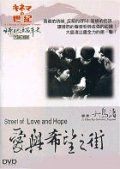
Street of Love and Hope
Rating: 8/10
Year: 1959
Genre: Drama
Director: Nagisa Oshima
Cast: Fumio Watanabe, Yoko Mochizuki
My feeling toward Nagisa Oshima's films is quite mixed. On the one hand, I enjoy his straightforward treatment of his subject matter as well as his incisive social critiques; on the other hand, I think his radical attitude and heavy theme are just too tough for general audience to appreciate.
Released in 1959, Street of Love and Hope is Oshima's first feature film... well, since it is only about 60 minutes long, and the plot is rather direct, and there is almost no sub-plot, in today's standard, it can also be viewed as a short film. Our protagonist is an impoverished high school student who is constantly trying his best to make money and share the family burden. He sells a pigeon that knows how to return home and he makes profit with it repeatedly. One day, he meets a girl who deeply sympathizes with his poor life. With the help of this girl, he is provided an opportunity to work in her father's factory, but then his cheating behavior is discovered by the boss of the factory and he is disqualified for the job... Unlike the complicated narrative structure of Oshima's later film, this directorial debut is definitely a pleasing one for general audience. The dialogues are plainly written and the theme is delineated in a straightforward manner. Through the miserable encounter of the boy, this film depicts the ruthless class conflict in our bureaucratic society and the discrepency between the living condition of upper-class and lower-class families.
Judging from the narrative, it seems that Oshima never really tries to be the verdict, as no judgement is made upon the behavior of the boy. Although the way he sells his pigeon is crooked, the movie does not position him as a criminal, nor does it say he is good or bad, it rather leaves this question to the audience. Perhaps if someone is to be blamed, it should be the society itself. The tragedy of the boy is not the fault of any individual but actually a by-product of social problems. From his actions in the film, it is clear that selling pigeon is always his last resort to make money. If he is given another opportunity, for instance, working in the factory or polishing shoes in the street, he would definitely go for it. But the fact is, he is disqualified for the factory job because of his bad record as a crook, and he is also dispelled by the police because he does not have a shoeblack license. With no alternative left, he is forced to sell pigeon again, and this cycle just goes on and on...
Talking about cinematic style, it inherits the typical characteristics of Japanese cinema. Slow-paced narrative structure and conventional editing are among those you can expect. Although Oshima is famous of his exploitation of cinematic forms and tools (for instance, the extremely long takes in The Night and Fog in Tokyo and the provocative subject matter and visual of In the Realm of the Senses), this time in his first movie, he didn't really spend too much time on the technical aspect but rather focused wholeheartedly on the story.
Considering its plain and direct narrative structure, Street of Love and Hope is absolutely a good novice material for anyone who wants to start learning about the master.
Reviewed by: Kantorates